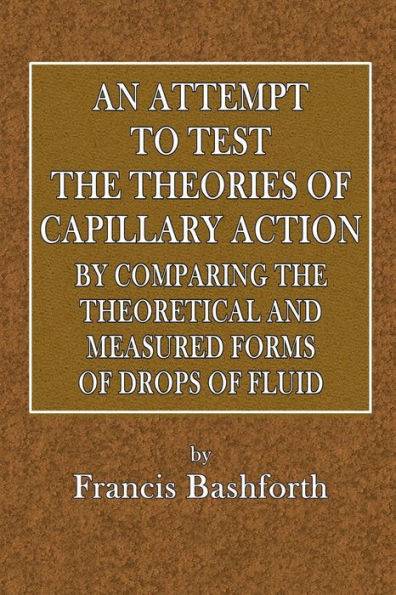An Attempt to Test the Theories of Capillary Action by Comparing the Theoretical and Measured Forms of Drops of Fluid: With an Explanation of Integration Employed in Construction of Integrating the Tables Which Give the Theoretical Forms
From the Introduction. Many years have elapsed since this work was commenced, and it is even now only partially completed. My object was to test the received theories of Capillary Action, and through them the assumed laws of molecular attraction, on which they are founded. To this end it was proposed to compare the actual forms of drops of fluid resting on horizontal planes they do not wet, with their theoretical forms. After some trials a satisfactory micrometrical instrument was constructed for the measurement of the forms of drops of fluid, but my attempts to calculate their forms as surfaces of double curvature failed entirely, and my undertaking must have ended here, if I had depended upon my own resources. But at this point Professor J. C. Adams furnished me with a perfectly satisfactory method of calculating by quadratures the exact theoretical forms of drops of fluids from the Differential Equation of Laplace, an account of which he has now had the kindness to prepare for publication. After the calculation of a few forms, application was made to the Royal Society for assistance from the Government grant in making the needful calculations. The following extracts from the application (Oct. 27, 1855) will explain the objects of the undertaking. "I have carefully examined all the published "experiments that I could meet with, but these have been generally made with "capillary tubes, and in consequence of the difficulties inherent in this mode of "observation they have not led to consistent and satisfactory results. "It appeared to me that the best test of theory would be obtained by making "careful measures of the forms assumed by drops of fluid resting on horizontal "planes of various solids"
1137555972
An Attempt to Test the Theories of Capillary Action by Comparing the Theoretical and Measured Forms of Drops of Fluid: With an Explanation of Integration Employed in Construction of Integrating the Tables Which Give the Theoretical Forms
From the Introduction. Many years have elapsed since this work was commenced, and it is even now only partially completed. My object was to test the received theories of Capillary Action, and through them the assumed laws of molecular attraction, on which they are founded. To this end it was proposed to compare the actual forms of drops of fluid resting on horizontal planes they do not wet, with their theoretical forms. After some trials a satisfactory micrometrical instrument was constructed for the measurement of the forms of drops of fluid, but my attempts to calculate their forms as surfaces of double curvature failed entirely, and my undertaking must have ended here, if I had depended upon my own resources. But at this point Professor J. C. Adams furnished me with a perfectly satisfactory method of calculating by quadratures the exact theoretical forms of drops of fluids from the Differential Equation of Laplace, an account of which he has now had the kindness to prepare for publication. After the calculation of a few forms, application was made to the Royal Society for assistance from the Government grant in making the needful calculations. The following extracts from the application (Oct. 27, 1855) will explain the objects of the undertaking. "I have carefully examined all the published "experiments that I could meet with, but these have been generally made with "capillary tubes, and in consequence of the difficulties inherent in this mode of "observation they have not led to consistent and satisfactory results. "It appeared to me that the best test of theory would be obtained by making "careful measures of the forms assumed by drops of fluid resting on horizontal "planes of various solids"
7.99
In Stock
5
1

An Attempt to Test the Theories of Capillary Action by Comparing the Theoretical and Measured Forms of Drops of Fluid: With an Explanation of Integration Employed in Construction of Integrating the Tables Which Give the Theoretical Forms
144
An Attempt to Test the Theories of Capillary Action by Comparing the Theoretical and Measured Forms of Drops of Fluid: With an Explanation of Integration Employed in Construction of Integrating the Tables Which Give the Theoretical Forms
144Paperback
$7.99
7.99
In Stock

Product Details
| ISBN-13: | 9781663556134 |
|---|---|
| Publisher: | Barnes & Noble Press |
| Publication date: | 08/25/2020 |
| Pages: | 144 |
| Product dimensions: | 6.00(w) x 9.00(h) x 0.34(d) |
About the Author
From the B&N Reads Blog
